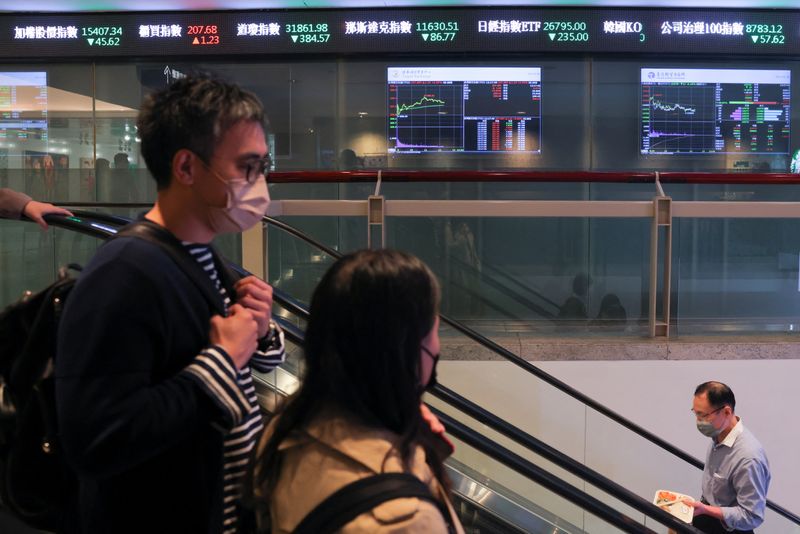
By Jamie McGeever
(Reuters) – A look at the day ahead in Asian markets.
Asian markets are poised to round off the week on a positive note on Friday, supported by gains on Wall Street, a weaker dollar and falling Treasury yields the day before.
But momentum looks sluggish, and if anything, investors in Asia are more likely to end the week with a limp over the finishing line rather than a burst of bullish optimism.
The local economic calendar is pretty full, with New Zealand manufacturing PMI, industrial production from India and Malaysia, and household spending, bank lending, trade and current account data from Japan all on tap.
Of the Japanese numbers, household spending is perhaps the most important, with investors looking for signals on how strong inflationary pressures are. The consensus forecasts point to monthly and annual declines in March.
Japanese policymakers appeared to take a hawkish turn at the Bank of Japan’s last meeting, however, with some board members seeing the chance of interest rates rising faster than anticipated.
Someone forgot to alert the FX market though – the yen didn’t get any obvious lift on Thursday, is hovering around 155.50 per dollar, and is down 1.5% this week.
Perhaps the most important economic data point of all comes on Saturday, when China releases April inflation. Economists polled by Reuters expect annual producer prices to remain deep in deflationary territory, and annual consumer price inflation to be barely positive at 0.1%.
China has been battling consumer deflation for about a year but it’s a fight Beijing is struggling to win – producer prices have fallen on a year-on-year basis every month since October 2022, and there is no sign of that changing any time soon.
remove ads
.
China’s economic recovery is progressing in fits and starts. Figures on Thursday showed a welcome rebound in trade activity in April with imports and exports swinging back to growth. Imports were much stronger than expected.
But other indicators have been less encouraging, and Citi’s economic surprises index is at a three-month low. Some analysts are speculating Beijing could end up driving down the yuan to engineer a sustainable recovery.
A devaluation of any magnitude is not without risk and may never come to pass. But the yuan is under pressure against a buoyant dollar and while capital outflows have slowed sharply, inflows have yet to meaningfully pick up.
Sino-U.S. trade relations continue to deteriorate, and on Thursday the Biden administration added 37 Chinese entities to a trade restriction list, including some for allegedly supporting the spy balloon that flew over the United States last year.
On the corporate front, Taiwan chipmaker TSMC, the world’s largest contract chipmaker, is expected to release its monthly sales figures on Friday, and in Japan automakers Honda (NYSE:) and Mazda are among the firms reporting full-year earnings.
Here are key developments that could provide more direction to markets on Friday:
– Japan household spending (March)
– India industrial production (April)
– New Zealand manufacturing PMI (April)
(Reporting and Writing by Jamie McGeever; Editing by Josie Kao)


